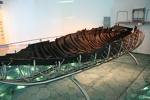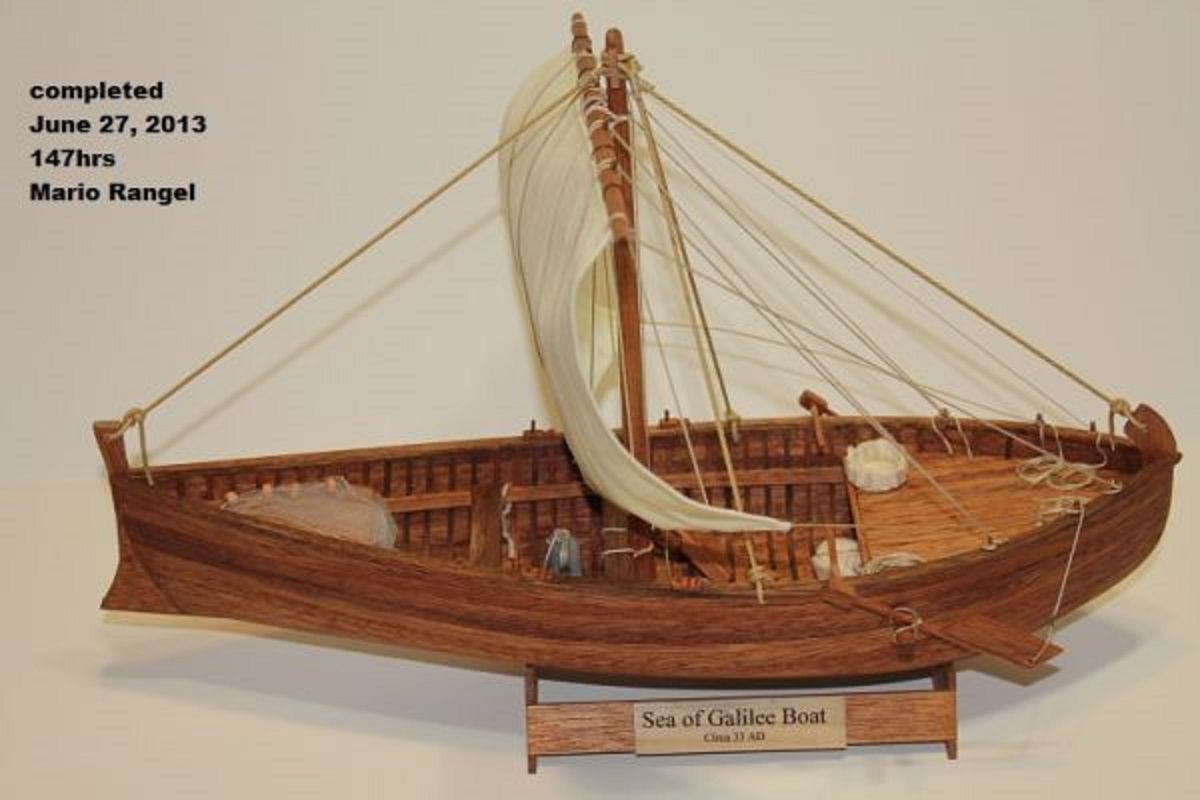- Latest Archaeology Updates
- Importance and applicability
- Famous Archaeologists
- Museums Collections
- Site Map
- World Heritage Sites
- World History Monuments
- Archaeological Organizations
- World Atlas of Archaeology
- Forensic Investigation and Geophysics
- Contact Us
- Movies based on Archaeology
- Frequently Asked Questions
- Archaeological discoveries
- Tell a Friend
- Archaeological Abbreviations
- Gallery Collections
- Famous-Museums site map
- Famous-archaeologists site map
- Archaeological Monuments site map
Galilee boatis a traditional fishing boat that is native to the Sea of Galilee region in the Middle East. The boats are made from locally available timber, typically cedar, and have flat bottoms and pointed prows. They are propelled by a single mast, which is rigged with a lateen sail. The sail is typically made of woven reed mats, and is one of the oldest known designs in the world. The lateen sail allows the boat to sail close to the wind, making it ideal for fishing in the shallow waters of the Sea of Galilee. The boat also features a rudder and a centerboard, which can be used to steer the boat. The centerboard is a removable plank that is attached to the bottom of the boat and can be raised or lowered to help with steering.
The traditional Galilee boat is usually about 8 meters (26 feet) in length and 2.5 meters (8 feet) in width. It has a shallow draft of around 0.5 meters (1.5 feet), allowing it to navigate the shallow waters of the Sea of Galilee. The boat can carry up to 15 people and their gear, making it ideal for fishing trips, transporting goods, or sightseeing.
The boat has been in use in the Sea of Galilee for centuries, and is still widely used today by both professional fishermen and recreational sailors. It is the traditional boat of the region, and is an important part of the local culture.
- The Galilee Boat is a wooden vessel from the first century that was discovered in the Sea of Galilee in 1986. It is thought to be the type of boat used by Jesus and his disciples for their fishing and missionary journeys. The boat is believed to have been built between 40 and 70 AD, making it roughly 2,000 years old.
- The boat was found in two pieces, with the hull preserved in remarkable condition. It measures approximately 8.2 meters (27 feet) long and 2.2 meters (7.2 feet) wide. The boat was constructed with the mortise-and-tenon jointing style, which was commonly used in the first century. The boat also features a unique design, which includes a flat bottom, a pointed bow, and a flat stern.
- The Galilee Boat is an important artifact from the time of Jesus, as it helps us to better understand the types of vessels used by his followers. The design of the boat is similar to those used by fishermen in the region during the first century, and it provides a tangible connection to the stories found in the Bible.
- The Galilee Boat has been featured in various films and TV shows, including Jesus of Nazareth, The Bible, and A.D. The Bible Continues. It has also been featured in numerous books, such as Jesus and the Boat: Exploring the Galilee Boat's Role in the Bible.
- The Galilee Boat is an important part of our understanding of the Bible and the life and ministry of Jesus. It helps us to better appreciate the context of Jesus' ministry and to understand the technology and culture of the time. The boat also provides a tangible connection to the stories found in the Bible, helping to bring the stories to life.
The Galilee Boat, also known as the Jesus Boat, is a 2,000-year-old fishing boat discovered in the Sea of Galilee in 1986. This boat, which is thought to have been used by Jesus and his disciples, provides an important archaeological record of the life of ancient Galileans. The boat was discovered in an ancient fishing village near the Sea of Galilee. It is the oldest known example of a wooden boat to have been discovered in the region. The boat is made of cedar and oak, and is around 27 feet long and eight feet wide. It is believed to have been constructed in the first century AD.
Archaeologists have used a variety of methods to determine the age and purpose of the boat. Carbon-14 dating has shown that the boat is more than 2,000 years old, and the construction techniques used to build the boat demonstrate that it was likely used as a fishing vessel. Moreover, the boat was found in an area where fishing was a common activity in the first century AD.
The boat is also important because it provides evidence of the types of boats used by the Galileans in the first century AD. The boat has a flat bottom and the shape and structure of the boat show that it was designed for fishing in the shallow waters of the Sea of Galilee. Additionally, the boat shows evidence of a sail, which indicates that it may have been used for transportation as well as fishing. The Galilee Boat is an important archaeological record of the life of ancient Galileans. It provides evidence of the types of boats used in the area, as well as the construction techniques used to build them. Moreover, the boat is a reminder of the life and ministry of Jesus and his disciples in the area.
Amesbury Archer (or King of Stonehenge) is an early Bronze Age man, dating to around 2300 BC. His grave is of particular importance because of the rich valuables and the earliest gold objects ever found in England.
Otzi the Iceman is well naturally preserved mummy of a man. The man who was been captured in Ice was believed to be over 53 centuries old (3300 BC).
Java man is an interesting discovery to note that the find was not a complete specimen, but consisted merely of a skullcap, a femur, and three teeth. Many scientists of the day even suggested that Dubois' Java Man might have been the so-called "missing link
Kennewick Man is the name for the remains of a prehistoric man found on a bank of the Columbia River near Kennewick, Washington, on July 28, 1996. The Kennewick Man news story is one of the most significant archaeology stories of contemporary times.
Neandertal1 or Neanderthal was a species of genus Homo (Homo neanderthalensis) that inhabited Europe and parts of western Asia during the last ice age.
Peking Man (sometimes now called Beijing Man), also called Sinanthropus pekinensis (currently Homo erectus pekinensis), is an example of Homo erectus.
The Red Lady of Paviland is a fairly complete Upper Paleolithic-era human male skeleton dyed in red ochre, discovered in 1823 by Rev. William Buckland in one of the Paviland limestone caves of the Gower Peninsula in south Wales, dating from c29,000.
The Tollund man lived during the late 5th century BC and/or early 4th century BC, about 2,400 years . He was buried in a peat bog on the Jutland Peninsula in Denmark, a find known as a bog body.
Turkana Boy, the designation given to fossil KNM-WT (Kenya National Museum-West Turkana), is a nearly complete skeleton of a 12-year-old hominid boy who died 1.6 million years ago.Turkana Boy is classified as either Homo erectus or Homo ergaster.
The Dead Sea Scrolls are a collection of about 850 documents, including texts from the Hebrew Bible, which were discovered in eleven caves near Qumran, in a fortress northwest of the Dead Sea in Israel.
The Narmer Palette, or Great Hierakonpolis Palette, is a significant Egyptian archeological find, dating from about 3200 BC, containing some of the earliest hieroglyphic inscriptions ever found, and depicting the unification of Upper and Lower Egypt under Narmer.
Rosetta Stone is a dark granite stone (often incorrectly identified as "basalt") which provided modern researchers with translations of ancient text in Egyptian demotic script, Greek, and Egyptian hieroglyphics.
Linear B is the script that was used for writing Mycenaean, an early form of the Greek language. It occurrs primarily on tablets dated from the 14th and 13th centuries BC.
The Sweet Track is an ancient roadway in the Somerset Levels, England. As of the early 2000s, it is the oldest known engineered roadway in the world. An grand footpath that ran for almost 2km across the Somerset levels swamps.
Tautavel Man is an ancestor of Neanderthal man, was slightly different from his contemporaries living Asia and Africa. In the village of Tautavel is located in the South of France, one of the most ancient humans was found: the Tautavel Man.
The Galilee Boat which is also referred as the "Jesus Boat" was found by local Galilean inhabitants in January 1986. The boat was wrapped in a polyurethane shell and then immersed in a special tank of water to avoid quick disintegration.
The monumental Ekron inscription is dated, statistically and historically, to the first half of the seventh century B.C.E. The five lines of the inscription are together with this in a slit open border.
It wasn't long back when a lot of scholars were quizzical the real survival of a Roman Governor with the name Pontius Pilate, the procurator who ordered Jesus' crucifixion. In June 1961 close to Caesarea-on-the-Sea (Maritima) was unearthed this appealing limestone block.
In 1990 ornately decorate limestone ossuary (bone depository) was found in Jerusalem's Peace Forest. In the ossuary were the bones of two babies, a adolescent child, a teenage boy, an adult woman, and a man about 60years of age.
In biblical Israel, papyrus was the main form of writing substance. Once an authorized deed was written, it would be rolled up, one end crinkled in one-third of the width and the contrary end likewise folded in.
It is the Capital city of a prehistoric principality in what these days is on the northern part of the Syrian coast, just north of the city of Latakia.


